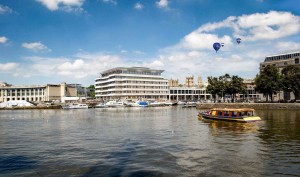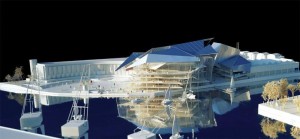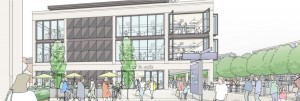Two major property developments could change the face of Bristol’s Harbourside, with the firms behind them promising to revitalise the area with mixed-used office and leisure schemes.
A £60m, six-storey Waterside building, pictured, on the vacant site between the Revolucion de Cuba bar and Lloyds Amphitheatre would include offices, shops and restaurants as well as a 210-space bike hub and a green roof. 
Meanwhile, under the second scheme the existing U-Shed building, which now houses the Za Za Bazaar – said to be the UK’s biggest restaurant – would be redeveloped into three new commercial/leisure units on the ground floor totalling around 900 sq m.
Above this would be nearly 4,000 sq m of high-quality offices, enough space, say developers CBRE, to accommodate up to 1,000 workers.
CBRE said the office element of its scheme, pictured below, would bring welcome additional spending to local businesses while the leisure space would bring a wider choice of food and drink to Harbourside.
Meanwhile, the team proposing the other building say it would be one of Bristol’s most sustainable new office and leisure buildings.
Its plans have been submitted to Bristol City Council by a joint venture between Railpen, asset manager for one of the UK’s largest pension funds, and Bell Hammer, the developer behind Assembly Bristol on Temple Way which was chosen by BT as its regional HQ.
The architects are Bristol’s award-winning AHMM, designers of Assembly Bristol and The Vincent.
The same team last year considered developing a seven-storey, 151-room hotel with restaurants and bars on the same site.
The new scheme would include elements that would help it achieve a 264% biodiversity net gain as well as solar panels generating renewable energy, they said.
The section on which the Waterside building is planned has remained undeveloped since the Harbourside area was regenerated from its original dockside industrial uses in the 1980s and 1990s. 
At that time it was earmarked for Bristol’s ill-fated performing arts centre. An eye-catching building designed by German architectural practice Behnisch and Behnisch, pictured, its advocates said it would do for Bristol what the Opera House has done for Sydney. However, it fell victim to Arts Council funding cuts and was scrapped.
Combined, the two schemes would transform Harbourside into an office zone as well as a leisure area at a time when property agents fear a shortage of prime office schemes could stifle the city’s growth and damage its reputation as a magnet for creative and tech businesses.
While a number of offices buildings are still under construction around the city, changes in the way firms are using employment space following the pandemic is driving demand for grade A space.
Railpen’s Richard Van Lente said: “We are hugely excited to be bringing forward these landmark plans that will provide a fantastic new office scheme that completes Millennium Square and enhances the harbourside for the local community and businesses alike.
“As well as creating hundreds of new jobs, we are determined to make this one of the most sustainable buildings in the South West, targeting BREEAM Outstanding.”
Joel Hawkins of Bell Hammer added: “With the success of Assembly and the strength of Bristol’s office market, we are confident occupiers will find Waterfront’s high-quality, flexible and environmental office space overlooking Bristol’s historic harbour an attractive proposition.”
Performing Arts Centre building picture source: Behnisch and Behnisch






























